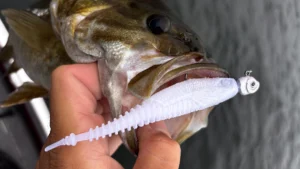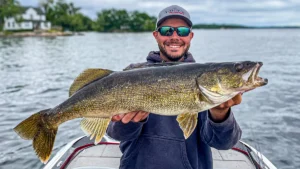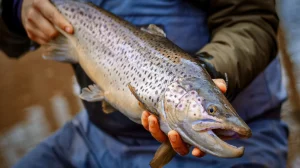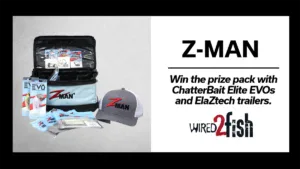I recently fished in my first big tournament in several years, the B.A.S.S. Nation Southeast Regional Qualifier on Lake Eufaula, in Alabama. Conditions were brutally tough during practice, with nightly lows in the 30s and a saturating soaker of a day midway through practice.
I had a shortened practice, in part due to my own decision not to fish one day and then motor trouble on another; though I’m not sure with the added practice I would have done much more than rule out even more unproductive water. The conditions were simply not conducive to getting bites in practice.
During the day and a half of practice I had, I only managed four bites. Two of them were close to 4-pounds, three came on a spinnerbait, and all four were in the same general area. This helped me narrow the 45,000 acre lake along the Alabama/Georgia line down to a couple hundred acres of productive water.
Going into Day 1, I committed to lock a spinnerbait in my hand most of the day in hopes of mustering up five bites in the 9 hours I would have to fish. This is a grinder’s deal, a hard way to fish, knowing that you’ll be tickled to work up a bite every hour and a half or so. A spinnerbait is one of my go-to confidence baits when the fishing is tough but big ones are around, especially during the pre-spawn.
The plan proved successful on Day 1, with seven bites coming my way and the best five weighing 14 pounds, 14 ounces, landing me in 16th place going into Day 2. On Day 1, I threw a spinnerbait 80 percent of the day, all seven bites came on it. Day 2 was tougher, with only three bites for 9 pounds, 12 ounces. The combined result of 8 fish for 24 pounds, 10 ounces came up shy of the Top 20 cut to fish on Day 3, leaving me in 25th at the end of my event.
I was a little disappointed, with the goal having been a Top 20 to qualify for the B.A.S.S. Nation National Championship. However, I was pleased with having converted what little I found in practice into a solid finish and a paycheck. I learned a lot too about fishing and myself. And I was reminded just how versatile a spinnerbait can be when I used two different spinnerbait setups for this event. That’s what I want to talk to you about today.
ONE-TWO PUNCH
A spinnerbait is my absolute favorite bait to throw during the prespawn. I have a ton of confidence in this lure. But not all spinnerbaits are made the same, and tweaking them a little will allow you to fish them in a wide variety of situations.
For this event, I had a 1/2-ounce Nichols Catalyst Colorado Willow Spinnerbait rigged up as well as a 3/4-ounce Z-Man Sling Bladez Colorado Willow Spinnerbait. I swapped out the included willow leaf blade on each bait for a No. 6 willow leaf blade, for added vibration and to help slow the baits down.
I used a Z-Man Elaztech Split Tail Trailerz on the 1/2-ounce bait, with a standard trailer hook that I like. And I used a True Bass Deer Hair Spinnerbait Trailer Hook on the back of the 3/4-ounce bait.
The baits were on similar action rods with similar reels, but the key difference in the setups was the line selection, opting for 40-pound Sufix 832 Braided Line with the 1/2-ounce bait and 17-pound Seaguar InvizX Fluorocarbon with the 3/4-ounce bait.
All of the decisions in the details of these setups were very intentional, to get the baits to where I could do different things with them.
HALF OUNCE SHALLOW
I’m very comfortable and confident fishing a spinnerbait around cover in 1 to 5 feet of water during the prespawn, especially when the water is muddy. On Lake Eufaula, there are literally miles and miles of shoreline and shallow flats to do this on. And as the spawn approaches, the big bass flood this cover and things can get right in a hurry.
The only problem with that particular week on Lake Eufaula was that the nightly lows in the 30s leading up to the start of the event had been just enough to keep the big bass at bay, staging them in deeper water adjacent to the spawning areas. I was able to find a few of those bass, they were the ones I would target with the 3/4-ounce bait, but we’ll get more into that in a moment.
The push shallow can happen quickly on Eufaula, and the big ones move in groups. So I knew with sunny days and warmer nights in the forecast for the tournament itself, I could potentially pull up on the right stretch and put 20 pounds in the boat—like I had in years past—in a matter of just a few casts. Knowing this kept my spirits up in spite of the tough fishing.
I targeted shallow wood and grass with the 1/2-ounce bait, relying on the braided line to get me out of a bind if a big one bit and tried to bury up in the cover. This happened a few times across the two days of the tournament: I caught three fish between 3 and 4 pounds coming out of a foot or so of water in sparse grass patches. I also caught a fish in the same size range alongside a laydown in about 3 feet of water.
The braid is the ticket when fishing around shallow cover. Braid floats but that doesn’t matter when fishing shallow, it actually helps keep the bait moving slowly without sinking as fast. Slow rolling these baits was critical to giving the fish time to react in the 50- to 54-degree water.
THREE-QUARTER OUNCE DEEP
To compliment the stingy shallow bite, I had one area where I could catch fish staging a little deeper, in 7 to 15 feet of water. This is where I used the 3/4-ounce bait rigged on fluorocarbon. Fluoro sinks, which helps a bait get deeper in the water column. Though the water was muddy enough that I could have fished braid, the buoyancy of the braid would have created a bow in my line that would have made it hard to fish the spinnerbait deep, especially with the large willow leaf blade.
To further help the spinnerbait get down, I upped the size from 1/2 ounce to 3/4 ounce. I then intentionally used the deer hair trailer hook as another added effort to help the bait get down and stay down. The hair on the trailer hook added a little flash and extra profile to the bait, while masking the trailer hook, all without adding any resistance to the bait the way a larger soft-plastic trailer would.
A twin-tail or even a swimbait trailer—though adding to the profile and action of a spinnerbait—also creates resistance and adds lift. This negative effect would have made it very hard to keep the bait on the bottom where the bass were positioned.
I used this bait to catch 4 of the 11 keepers I caught through the two days of competition, the other 7 coming on the shallow spinnerbait setup. The biggest impact of the deep blade came on Day 2, when I spot a couple fish on my 2D sonar sitting on a drop-off from 9 to 17 feet of water— one right on top of the drop and the other suspended a few feet in front of the break.
I trolled off, turned and triangulated the best I could to cast to where I thought the fish were, chucked my blade out a couple times and boated a bass a little over 3 pounds, having to count the bait down about 10 seconds until it could hit the bottom and then absolutely crawling it back to the boat.
A couple casts later, while counting the bait down in the same area, I realized it had been more than 10 seconds, and I still hadn’t felt my bait hit the bottom. I pulled tension into my line so that I could get the blade to turn and determine whether the bait was still falling or sitting on bottom. I found that a fish had eaten it on the fall—another 3-pounder. These two bites came on near back-to-back casts, with the other 700 or so casts of the day producing only one other bite, a 3.5- pounder shallow.
FINAL THOUGHTS ON SPINNERBAITS
Absolutely brutal fishing, but again it was enough to finish 25th out of 160 boats or so. When the fishing is that tough, you have to have confidence in what you’re doing. Had I not gotten a single bite in practice, I would have been confident going shallow with the 1/2-ounce bait on braid and just running new water. I knew that if I made enough casts at shallow cover, I’d eventually run into a few bass, given the shallow and muddy, pre-spawn conditions.
Fortunately, I had an area where I had gotten a few bites and was able to bear down and do most of my work there, expanding on the area a bit and sampling other areas that were similar to it on the way to and from. Hopefully my experiences in this recent tournament will help you catch more fish on a spinnerbait this spring in your neck of the woods.
*Fellow Wired2Fish contributor Sam Hanggi also fished this event, placing 10th after three days of competition. Be on the lookout for his writeup on how he caught them, fishing a different pattern on the same stingy waterway.



















